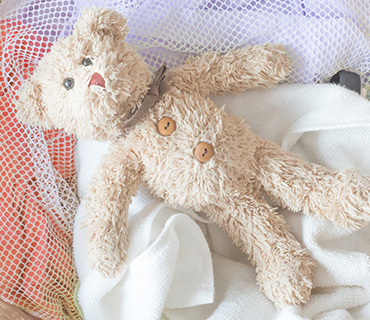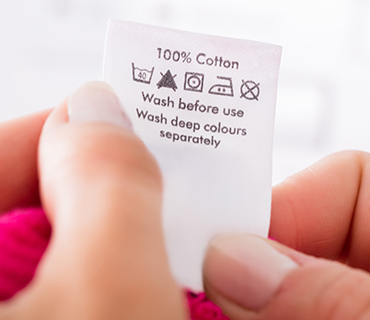Important: Sometimes, when someone has a stomach bug, for example, it’s important to know how to kill germs by disinfecting your laundry. Read on to learn the difference between deep cleaning, sanitizing, and disinfecting and when and how to perform each.
Laundry Hygiene Tips to Prevent Germs or Illnesses from Spreading
During an average day, you’re likely to pick up a hodgepodge of bacteria and other germs from people and objects, some of which can transfer onto your clothes. On other days, you or someone in your household might be sick with a respiratory virus or a stomach bug.
In most cases, deep laundry cleaning is enough to avoid spreading germs and the infections they can cause (using a few extra laundry-handling precautions if COVID-19 illness is suspected or confirmed, per the CDC laundry guidelines. In other cases, you may just want to sanitize difficult-to-wash items or items in between washes.
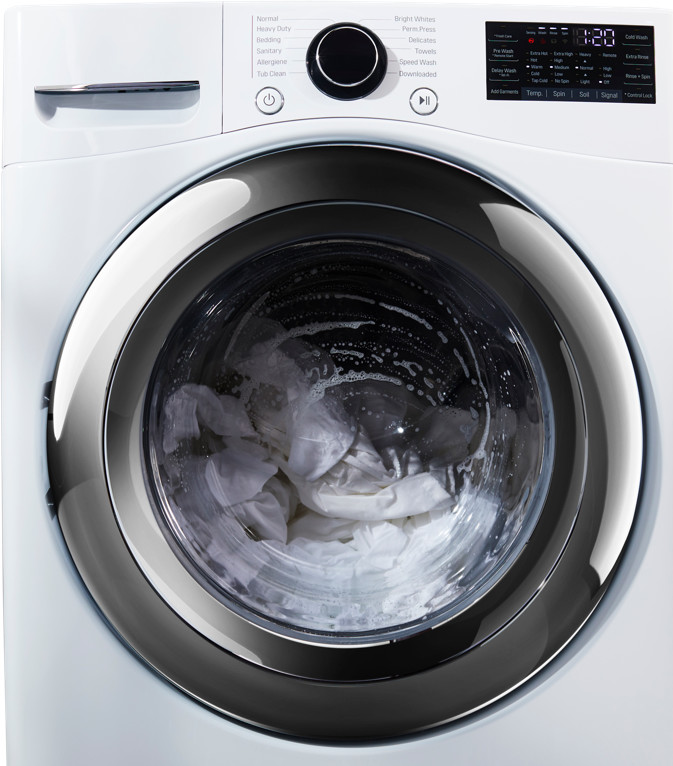
The Difference Between Deep Cleaning, Sanitizing, and Disinfecting
Deep Cleaning works by using a high-quality detergent, water, and agitation to physically remove soils, stains, and germs from fabrics so they get rinsed down the drain with the water. Deep cleaning does not kill germs. Sanitizing and Disinfecting products contain chemicals that kill germs, and they are regulated by the US Environmental Protection Agency (EPA). Generally, sanitizers reduce the number of certain bacteria (by up to 99.9 percent) to a safe level, while disinfectants kill bacteria and other germs like viruses.
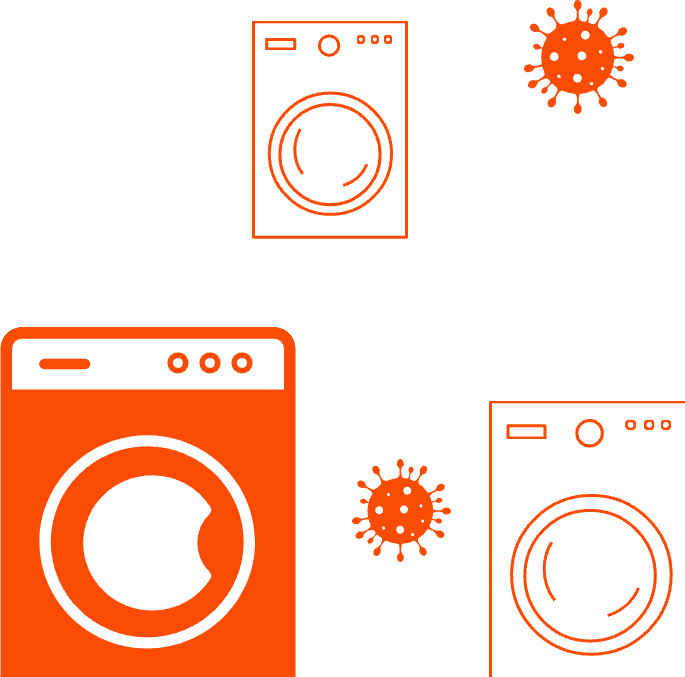
| Deep Cleaning | Sanitizing | Disinfecting | |
| What does it do? | Removes soils, stains and dirt. | Reduces the number of certain bacteria. | Kills bacteria and other germs, like viruses. |
| When do you need it? | Everyday cleaning. | For laundry from people who might be ill with a stomach virus like rotavirus or laundry that is heavily contaminated with body fluids. | For laundry from people who might be ill with a stomach virus like rotavirus or laundry that is heavily contaminated with body fluids. |
| Products to use | A high-quality, deeper cleaning detergent. | EPA-registered sanitizing & disinfecting products. | EPA-registered sanitizing & disinfecting products. |
When and How to Deep Clean Laundry
Generally, normal laundry cleaning guidelines apply if illness or exposure to illness (including COVID-19) is not suspected:
If you are caring for immune-compromised persons, or if your household is experiencing contagious illnesses, it is best to follow your healthcare provider’s advice.
Everyday clothing and outerwear can be washed in cold water with the appropriate dose of a high-quality laundry detergent, such as Tide.
Underwear, sports clothing, towels, and sheets may need an extra boost of cleaning power by washing in warm water (80? F or higher) with the appropriate dose of a high-quality laundry detergent.
To help prevent damage to laundry items, be sure to check the care labels for washing and drying instructions.
How to Handle and Wash Laundry Safely When Someone is Suspected or Confirmed to Have COVID-19
If COVID-19 is suspected, or if it has been confirmed, follow the CDC laundry guidelines using a high-quality detergent like Tide. The CDC guidelines focus on deep cleaning while preventing transmission from contaminated clothing, towels, linens, and other items to people:
The CDC also has guidelines for disinfecting surfaces that may have come into contact with the contaminated clothes, like the outer surfaces of your washer: CDC guidelines. And the EPA has a list of disinfectants registered for use against SARS-CoV-2.
Launder items according to the manufacturer’s instructions. Use the warmest appropriate water setting and dry items completely.
Wear disposable gloves when handling the dirty laundry of a person who is sick.
A sick person’s dirty laundry can be washed with other people’s items.
Do not shake dirty laundry.
Clean and disinfect clothes hampers according to guidance above for surfaces.
Remove gloves, and wash hands right away.
When and How to Sanitize or Disinfect Laundry Using Products
For laundry from people who might be ill with a stomach virus like rotavirus, or for laundry that is heavily contaminated with body fluids, we suggest the following:
Always wash hands following the CDC guidelines when handling contaminated laundry; including after you transfer clothes from the washer to the dryer.
Rinse off any excess body fluids using warm water, and wash items immediately.
Consider washing in hot water, or the warmest water allowed by the item’s care label.
Use the appropriate dose of a high-quality laundry detergent like Tide, plus an additive that is registered with the EPA as a sanitizer or disinfectant. (The EPA provides a list of disinfectants registered for use against common disease-causing germs.)
Repeat if stains or residues remain after washing.
Dry items thoroughly on the highest heat cycle allowed by the item’s care label.
Important: Have doubts about whether a garment is safe to wash in hot water and/or chlorine bleach? Don't guess. Check the care labels for specific washing instructions, and also check the instructions on the additive label. First, test for colorfastness in an inconspicuous area by following the instructions on the product label.
When and How to Sanitize Laundry Using the Sanitize Cycle on Your Washing Machine
If someone in your family has been sick, if you’re a healthcare worker, or if you have cloth diapers in your household, and you have a sanitize setting on your washing machine, don’t be afraid to use it! Designed to eliminate 99.9 percent of the bacteria in your laundry, the sanitize setting can also help ensure there won’t be any significant carryover of bacteria to subsequent loads of laundry.
Sanitize Cycle These cycles use elevated wash temperatures to effectively sanitize your items. Under most circumstances, sanitize cycles must reach a temperature of 149°F (65°C). This is achieved by utilizing an internal heating element to heat the water bath.
Sanitize with Oxi Cycle These cycles use chemistry with hot water to sanitize your items. Cycles are designed to utilize incoming water heated to 120°F (49°C) with an Oxi additive included with the detergent in the wash load.
Important: Have doubts about whether a garment is safe to wash in hot water and/or with an Oxi additive? Don't guess. Check the care labels for specific washing instructions, and also check the instructions on the additive. First, test for colorfastness in an inconspicuous area by following the instructions on the product label.
When and How to Deep Clean Your Washing Machine
The condition of your washer has a significant impact on the cleanliness of your laundry. Regular cleaning of your washing machine is a simple process, and it should be done on a monthly basis.
To prevent washing machine smells that can transfer odors to your clothes, use Tide’s Washing Machine Cleaner, and follow the guide below to deep clean your washing machine:
Step 1

Wipe your washer regularly with soapy water or a disinfecting wipe, making sure to clean the inside of the drum as well as the outside of the machine.
Step 2
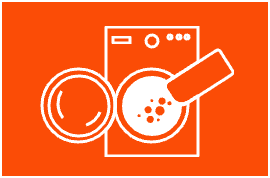
Pour Tide’s Washing Machine Cleaner into the drum to clean away detergent residue and laundry odors.
Step 3
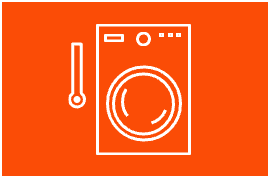
Run your washer on a hot, empty cycle, and let Tide’s Washing Machine Cleaner take care of the rest.
Tip Box
Here are a few extra tips to help reduce the risk of germs spreading from soiled or contaminated laundry:
Always wash your hands for 20 seconds using soap and warm water after handling soiled laundry – even when transferring clothes from the washer to the dryer.
Remove your clothing in a room that has hard, easy-to-disinfect surfaces, instead of piling dirty laundry on your bed, for example.
Clean your laundry bag regularly. If it’s made of fabric, wash it, and if it’s plastic, wipe it with a disinfecting wipe.
Always use the correct dose of laundry detergent for the size and degree of contamination of your load.
Avoid overloading your washing machine.
Wash heavily contaminated items separately on the warmest wash setting allowed by the care label – ideally with a registered sanitizing or disinfecting additive.
Dry items thoroughly on the highest heat cycle allowed by the care label.
Related products
Tide Hygienic Clean Heavy Duty 10X Power PODS® Original Scent





